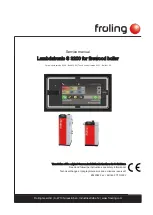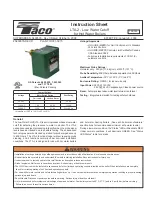
S
ECTION
250
CONTINUED
F.
R
ELIEF
V
ALVES
(1)
The storage tank should be protected with a pressure (or combination temperature and pressure) relief valve set so as not to exceed the maximum
tank operating pressure. The relief valve should be located within 6" of the top of the tank. Refer to local codes for the type of relief valve required.
(2)
Each heater should be protected with its own pressure relief valve. The relief valve should be rated for the BTU/hr or LBS/hr of heater output.
(3)
The pressure relief valves and pressure relief elements of combination valves, when supplied, shall comply with applicable performance provisions of the
American National Standard for Relief Valves and Automatic Shutoff Devices for Hot Water Supply Systems, ANSI Z21.22-1979.
(4)
Manually operate relief valves at least once a year.
(5)
If the temperature and pressure relief valve(s) on the appliance(s) discharge periodically, a problem exists and service to the water system is required. Periodic
discharge may be due to thermal expansion in a closed water system.
CAUTION!!!
To prevent scalding and/or personal injury, pipe outlet of relief valve(s)
to a floor drain with NO intervening valves or restrictions.
G. A
IR
E
LIMINATION
(A)
All of the air must be removed from the water piping in the system before the system will function properly. Therefore, all high points in the system must be
vented or purged. Relief valves may be used to purge air when they are at the high point.
(B)
If a water heater is installed in a closed water system, contact the water heater supplier or local plumbing inspector on methods to allow proper system expan-
sion. A weeping pressure or temperature relief valve may be due to thermal expansion (i.e. expansion tanks) in a closed water system. Do not plug the tem-
perature and pressure relief valve.
H. V
ENTING
S
YSTEM
(F
LUE
G
ASES
)
(1)
Vents for the heater(s) may be run individually or manifolded. Two or more heaters may be vented through a common vent connector or manifold. The common vent
connector or manifold shall be located at the highest level consistent with available head room or clearance to combustible material, and shall be sized in accordance with
approved engineering methods. The area of the common vent connector or manifold shall not be less than the combined area of the individual draft hood outlets or the
individual vent connectors.
See the NATIONAL FUEL GAS CODE ANSI Z21.13-1984 Section 1.5 "Venting of Appliances" for more detailed information.
(2)
Only locally approved code type venting should be installed.
(3)
The draft hood furnished with each heater/boiler must be installed as shown on the hook-up diagram.
(4)
The sheet metal collar included with the heater musted be installed between the heater & the draft hood.
I.
G
AS
C
ONNECTION
(1)
The gas line should be a separate line running directly from the gas meter to the heater, unless the existing gas line is of ample capacity. Verify the capacity of
the existing gas piping if it is to be used.
(2)
Install a union at the connection to the heater manifold.
(3)
Refer to the rating plate on the shell of the heater for proper gas manifold pressure. The manifold pressure is measured downstream of the gas pressure regu-
lator. Do not exceed the maximum gas pressure specified on the rating plate.
(4)
A trap (drip leg) must be installed upstream of the gas pressure regulator.
(5)
The heater must be disconnected from the gas supply piping system during any pressure testing of the gas supply piping.
(6)
Gas connections and heater should be properly tested for leaks before being put into operation.
(7)
Gas supply lines should be purged of air at the heater before startup.
(8)
The flow rate is determined by controls preset at the factory. There is no field adjustment for the minimum input rate.
J. T
ESTING
(1)
Your heater has been pressure tested in accordance with ASME CODE SECTION IV and fire tested in accordance with U.L. 795.
(2)
It is recommended that the heater and the system into which it is installed be tested before operating the system. The exact nature of the test(s) are deter-
mined by the system's component(s), but will generally consist of a water pressure test and a gas leak test. This testing should be completed as part of the
normal installation procedure by the installing company.
(3)
Once the entire installation is complete, the unit should have an operation test to insure that the ignition system safety shut of device works properly.
Instructions in the manufacturer's literature shall be followed in conducting this test.
K. M
AINTENANCE
CAUTION
The following inspections and tests should be performed
at regular intervals at least every three to six months.
Failure to do so may void your warranty.
(1)
Turn the Operating Thermostat and High Limit Aquastat down, then up until heater turns off and on to verify that the controls are operating satisfactorily.
(2)
Check the High Limit Aquastat Well for lime. If 1/16" lime is deposited on the outside of the well, the coil needs to be delimed.
(3)
Inspect the coil and burner assembly to make sure that they are free from dust, lint, dirt, etc. If they are dirty, remove all foreign material by washing, flushing,
or air cleaning, etc.
(4)
Inspect venting system to make sure that it is free of dirt and corrosion.
(5)
Make periodic visual checks of burners and pilot flames.
(6)
Check combustion air inlets in the room to see that they are clear of obstructions.
L. A
QUASTAT
I
NFORMATION
(1)
The Heater is equipped with two aquastats - a high limit safety aquastat in the upper (hot out) manifold and an operating aquastat (Thermostat ) in the lower
(tank water in) manifold. The operating aquastat “Thermostat” should be set approximately 10°F lower than the desired tank tamperature setting.
The HI limit
aquastat should be set at least 60°F higher than the thermostat setting.
For example: if desired water temperature in tank is 140°F set the thermostat at
130° F and Hi limit at 200°F; for 150°F tank water temperature set the thermostat at 140°F and the Hi limit at 210°F. etc. When 2 or more heaters are operated
together, set the 2nd heater thermostat 3° to 5° lower than the first heater thermostat and the third heater thermostat 3° to 5° lower than the 2nd heater thermo-
stat, etc. Check the tank thermometer and correct thermostat so that the heater shuts off at desired tank water temperature.
Note: tank aquastat may be used interchangeably with the heater operating aquastat.
(2)
Water entering heater below 140 °F will cause the heater to condense, limiting its service life.





































